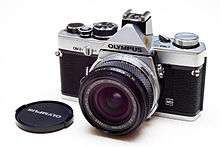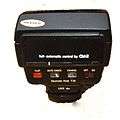Olympus OM-2
 Olympus OM-2n | |
| Overview | |
|---|---|
| Maker | Olympus |
| Type | 35 mm single-lens reflex (SLR) |
| Lens | |
| Lens mount | Olympus OM |
| Focusing | |
| Focus | Manual |
| Exposure/Metering | |
| Exposure | 1/1000 ~ 1 s, bulb (B), aperture priority (Av) |
| Exposure metering | Off-the-film (OTF) TTL |
| Flash | |
| Flash |
Hot shoe, PC socket |
The Olympus OM-2 is a single-lens reflex film system camera produced by Olympus of Japan.
Main Features
The Olympus OM-2 is an aperture-priority automatic-exposure camera (with full manual operation selected via switch), based on the earlier, successful Olympus OM-1 body. The OM-2 was introduced in 1975,[1] and combined the light, sturdy camera body style of the manual-only OM-1 with a new automatic exposure system.
One of the main selling points of the OM-2 was that all of the OM-1 accessories and lenses would fit without modification, offering a complete photographic system which could be carried easily, and allowing OM-1 owners an easy upgrade path. Although the camera was promoted in photography publications and magazines as technically superior, Olympus as a company did not have the same recognition as Nikon or Canon and, as a result, some professionals considered the cameras inferior due to their lighter weight.
Technical details
Of the many features the OM-2 boasted, the most commonly advertised feature was that it was the first camera to offer a TTL direct metering system for film,[2] named Auto Dynamic Metering (ADM). This "off the film metering" was the first ever. Another feature of the OM-2 was the integration of two available electronic flash guns into the system.[3] The camera set the duration and intensity of the flash during exposure using its inbuilt sensors by measuring the amount of light reflected off the film. This ensured excellent results under difficult conditions. Exposure calculation was unique thanks to the twin "silicon blue cell" sensors which, for shutter speeds of 1/60s and above, measured light reflected off a graduated patterned surface on the lens side of the shutter. For shutter speeds below 1/60s, exposure was calculated from the amount of light reflected off the film surface during the exposure.[4] The shutter was a horizontal-running cloth type. In auto-exposure mode the camera was capable of giving exposures from 60s-1/1000s (OM-2N, 120s-1/1000s). The camera also offered a metered manual-exposure mode, with speeds of 1s-1/1000s, plus B.
Physical Appearance and features
The model series appeared in the following order: OM2, OM2 MD, OM2n MD and thereafter the heavily revised OM2S/OM2 Spot Program which was, essentially, a new mechanism within a similar body.
The OM2, OM2 MD and OM2n MD camera came in chrome or black finish. The OM2S (In USA) and OM2 Spot/Program (elsewhere) came only in black.
OM2 and OM2 MD
The principle difference between the OM2 and OM2 MD models was the provision of a removable cap on the base-plate to permit attachment of the OM system Motor Drive 1 (or the later Motor Drive 2) for film advance at 5 frames per second and the placement of an "MD" badge on the front left face of the camera. The non-MD badged OM2 cameras needed to go to a service facility to enable attachment of a motor drive.
OM2 and OM2 MD cameras had the accessory shoe 2 or 3 for attaching a flash unit. This had the central sync contact plus one other (either in-line or off to the 10-o-clock position when viewed from the rear of the camera) and a single, threaded post on the prism used to secure the shoe or a post with one small recess for a connector pin (Shoe 3). Additionally, the OM2 and OM2 MD models had a re-set position on the shutter speed dial adjacent to the B setting. This was used to re-set the shutter mechanism in the event of mirror lock-up when the batteries were drained.
OM2n MD
The OM2n MD, manufactured from 1979 to 1984, has a lower-case "n" engraved next to the model number on the front plate at the rewind lever and on the top plate, to the left of the prism. Additionally, the re-set function was moved to the top of the camera via the power-switch and the word "Reset" is engraved next to the word "Check" on the top plate of the camera.
The "n" model had a new, re-contoured advance lever which had smoother, rounded edges as opposed to the OM2 and OM2MD's advance lever's slimmer and sharper edges.
The OM2n MD used accessory shoe 4 with two additional contacts above the main central sync point. This shoe used two small pins to make contact with the camera circuitry. For this purpose an OM2n MD will have the large securing threaded recess used for shoe 1 on the older OM2 MD plus two smaller recesses for the added contacts visible on the rear of the prism above the viewfinder. The flash shoes are not backwardly interchangeable between models.
The OM-2n MD added, via the shoe 4 circuitry, the following features to the OM2 MD: A flash charge-ready light in the viewfinder and correct flash exposure confirmation by flashing this same green LED after exposure.
The "n" also had a contact inside the film chamber for the Recordata back. Finally, if used with a T-Series flash, the flash and shutter would sync at "X" setting regardless of what position the sync switch around the pc-socket was set to.
OM2S/OM2 Spot Program
The OM-2SP Spot Program (OM-2S in the USA) was a thorough overhaul of the OM2 innards to make the model more competitive. It has more commonality with the OM4 than the previous OM2, a fact which simplified production for Olympus which had, by the time of the OM2S launch, released the OM4 and the OM3 models. It was manufactured from 1984 to 1988.
The OM2S used the OM4 shutter mechanism but without the 1/2000 sec top speed, using instead 1/1000 as the maximum. It did, however, retain its mechanical Bulb setting as well as 1/60 second speed for use when batteries were depleted. This addressed a failing of the older all-electronic OM2 models which were unusable without batteries. Additionally, a basic level of weather-sealing was provided as a new feature in the OM2 line. While the older OM2 models could routinely withstand harsh conditions, they were never advertised as having any environmental protection features.
The OM2S offered only 3.5 frames per second when coupled to the motor drive 1 or 2.
The camera used an LCD display with a 90 second power-saving limiter for metering indications and warnings. This was visible to the left of the viewfinder area.
All the previous focusing screens and accessories (with the exception of the flash shoe attachments) available in the OM system were compatible with the camera.
The camera body had a fixed hot-shoe and a plug on the front-left for coupling of the Olympus flash group's TTL connector cable (previously the OM2n MD series required removal of the flash shoe and the attachment of a TTL connector to facilitate this).
The rewind release was moved from the front right faceplate to the top of the camera between the ASA setting dial and the advance lever arm.
The OM2S had three operational modes. The most noted was the provision of a program setting which permitted totally automated selection of aperture and shutter speed by the camera circuitry.
Olympus offered a program mode without the need for modification of existing lenses or the purchase of special program-compatible lenses. The only proviso to using program mode was that the lens in use be set to the highest f-number to permit the program mode to operate. If the aperture was not set to the highest number, the LCD display would flash an aperture symbol (and, if activated, the camera beeper would sound) to warn of the problem.
The "Auto" mode operated in much the same manner of the older OM2n MD offering aperture preferred automatic exposure with averaging metering off the first curtain and/or film to determine which shutter speed would be used for the exposure.
The "Manual" mode metered in the central microprism collar area only (roughly 2% of the field) - giving the spot metering in the camera's model name. Information on the spot metered value was provided on an LCD bar-graph version of the older match-needle system used on the OM2n MD. Both shutter speed and aperture were under the photographer's control.
Metering circuit changes versus the OM2/OM2n
The OM2S still made use of the direct off the film metering although the OM2S used a single metering cell in the base of the mirror box for all metering. On the earlier OM2n MD model series the dynamic metering was accomplished via two silicon blue cells mounted just behind the lens mount which were aimed at the first curtain/film surface. The meter needle for the viewfinder was driven by a cds cell mounted in the prism.
The OM2S used the same metering cell for all operations and light for the preview reading was sent to the cell via a secondary mirror mounted behind the semi-opaque main mirror as in the OM3 and OM4 models.
The self-timer on the OM2S was electronic. On activation the mirror would lock-up until exposure. If cancelled at any point the shutter would complete the exposure. The self-timer switch, placed where the previous-generation models had a mechanical self-timer arm, permitted the battery check/self-timer beep to be silenced.
A button to the right of the prism provided a 16 second illumination of the LCD metering display in the viewfinder for use in dark conditions.
 Olympus OM-2 with Zuiko 50mm f1.8 lens
Olympus OM-2 with Zuiko 50mm f1.8 lens Olympus OM-2SP
Olympus OM-2SP Dedicated TTL strobe T-32 for Olympus OM2
Dedicated TTL strobe T-32 for Olympus OM2 T-32
T-32
References
- ↑ Functional Photography. 14-15. Photographic Applications in Science and Technology, inc. 1979. pp. 22–24.
- ↑ http://www.olympus-global.com/en/corc/history/camera/om.cfm Olympus Official Historical Site
- ↑ H. Greenwood, 1983. The British Journal of Photography. Liverpool Photographic Society.
- ↑ Michael Mcbroom (2000). McBroom's Camera Bluebook: The Complete, Up-to-Date Price and Buyer's Guide for New and Used Cameras, Lenses, and Accessories. Amherst Media, Inc. ISBN 9781584280132.
External links
![]() Media related to Olympus OM-2 at Wikimedia Commons
Media related to Olympus OM-2 at Wikimedia Commons